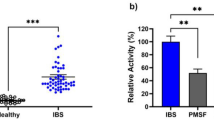Abstract
Background
Irritable bowel syndrome (IBS) pathophysiology has not been fully understood. Abnormalities of serine proteases have been identified in IBS patients. In addition, protease-activated receptors (PAR) activation interferes with several components of the pathogenesis of IBS, so, evaluating the PAR expression in IBS patients may contribute to understanding the pathogenesis of the disease.
Aims
This study aimed to investigate whether the expression of PAR4 and PAR2 in the colon was changed in IBS patients and was associated with IBS.
Methods
Colon mucosal biopsies of 34 IBS patients (16 constipation- and 18 diarrhea-predominant) and 18 control subjects were collected. Gene transcripts of PAR2, PAR4, tryptase, and trypsin were quantified using real-time polymerase chain reaction (PCR) and the expression of PAR2 and PAR4 receptors was also measured by immunohistology and image analysis.
Results
In IBS patients, the mRNA expression of tryptase and trypsin normalized against β-actin gene was higher compared to control subjects (P < 0.001). No difference was observed in the PAR2 mRNA level or protein level between control subjects on the one hand and IBS patients or subgroups on the other. In IBS or IBS subgroups patients, the expression of PAR4 in the mRNA level or protein level was lower than the control subjects.
Conclusions
This study, for the first time, indicated the PAR4 expression in IBS patients. Decreased PAR4 expression may help us to understand the pathogenesis of IBS.



Similar content being viewed by others
References
Drossman DA, Corazziari E, Delvaux M, et al. The functional gastrointestinal disorders. 3rd ed. Washington: Degnon; 2006.
Coughlin SR. How the protease thrombin talks to cells. Proc Natl Acad Sci USA. 1999;96:11023–11027.
Vergnolle N. Clinical relevance of proteinase activated receptors (PARs) in the gut. Gut. 2005;54:867–874.
Kawabata A, Kuroda R, Nishida M, et al. Protease-activated receptor-2 (PAR-2) in the pancreas and parotid gland: Immunolocalization and involvement of nitric oxide in the evoked amylase secretion. Life Sci. 2002;71:2435–2446.
Oikonomopoulou K, Hansen KK, Saifeddine M, et al. Kallikrein-mediated cell signalling: targeting proteinase-activated receptors (PARs). Biol Chem. 2006;387:817–824.
Vergnolle N. Modulation of visceral pain and inflammation by protease-activated receptors. Br J Pharmacol. 2004;141:1264–1274.
Lourbakos A, Yuan YP, Jenkins AL, et al. Activation of protease-activated receptors by gingipains from Porphyromonas gingivalis leads to platelet aggregation: a new trait in microbial pathogenicity. Blood. 2001;97:3790–3797.
Vergnolle N, Bunnett NW, Sharkey KA, et al. Proteinase-activated receptor-2 and hyperalgesia: a novel pain pathway. Nat Med. 2001;7:821–826.
Cenac N, Andrews CN, Holzhausen M, et al. Role for protease activity in visceral pain in irritable bowel syndrome. J Clin Invest. 2007;117:636–647.
Cenac N, Chin AC, Garcia-Villar R, et al. PAR2 activation alters colonic paracellular permeability in mice via IFN-gamma-dependent and -independent pathways. J Physiol. 2004;558:913–925.
Ramachandran R, Hollenberg MD. Proteinases and signalling: pathophysiological and therapeutic implications via PARs and more. Br J Pharmacol. 2008;153:S263–S282.
Xu WF, Andersen H, Whitmore TE, et al. Cloning and characterization of human protease-activated receptor 4. Proc Natl Acad Sci USA. 1998;95:6642–6646.
Asfaha S, Cenac N, Houle S, et al. Protease-activated receptor-4: a novel mechanism of inflammatory pain modulation. Br J Pharmacol. 2007;150:176–185.
Augé C, Balz-Hara D, Steinhoff M, et al. Protease-activated receptor-4 (PAR 4): a role as inhibitor of visceral pain and hypersensitivity. Neurogastroenterol Motil. 2009;21:1189-e107.
Drossman DA, Dumitrascu DL. Rome III: new standard for functional gastrointestinal disorders. J Gastrointestin Liver Dis. 2006;15:237–241.
Livak KJ, Schmittgen TD. Analysis of relative gene expression data using real-time quantitative PCR and the 2−ΔΔCt method. Methods. 2001;25:402–408.
Róka R, Wittmann T, Bueno L. Altered protease signalling in the gut: a novel pathophysiological factor in irritable bowel syndrome. Neurogastroenterol Motil. 2008;20:853–856.
Reed DE, Barajas-Lopez C, Cottrell G, et al. Mast cell tryptase and proteinase-activated receptor 2 induce hyperexcitability of guinea-pig submucosal neurons. J Physiol. 2003; 547:531–542.
Coelho AM, Vergnolle N, Guiard B, et al. Proteinases and proteinase-activated receptor 2: a possible role to promote visceral hyperalgesia in rats. Gastroenterology. 2002;122:1035–1047.
Gecse K, Róka R, Ferrier L, et al. Increased faecal serine protease activity in diarrhoeic IBS patients: a colonic lumenal factor impairing colonic permeability and sensitivity. Gut. 2008;57:591–599.
Kawabata A, Kuroda R, Nagata N, et al. In vivo evidence that protease-activated receptors 1 and 2 modulate gastrointestinal transit in the mouse. Br J Pharmacol. 2001;133:1213–1218.
Róka R, Ait-Belgnaoui A, Salvador-Cartier C, et al. Dexamethasone prevents visceral hyperalgesia but not colonic permeability increase induced by luminal protease-activated receptor-2 agonist in rats. Gut. 2007;56:1072–1078.
Hansen KK, Sherman PM, Cellars L, et al. A major role for proteolytic activity and proteinase-activated receptor-2 in the pathogenesis of infectious colitis. Proc Natl Acad Sci USA. 2005;102:8363–8368.
Jacob C, Yang PC, Darmoul D, et al. Mast cell tryptase controls paracellular permeability of the intestine. Role of protease-activated receptor 2 and beta-arrestins. J Biol Chem. 2005;280:31936–31948.
Karanjia R, Spreadbury I, Bautista-Cruz F, et al. Activation of protease-activated receptor-4 inhibits the intrinsic excitability of colonic dorsal root ganglia neurons. Neurogastroenterol Motil. 2009;21:1218–1221.
Kawabata A, Kuroda R, Kuroki N, et al. Dual modulation by thrombin of the motility of rat oesophageal muscularis mucosae via two distinct protease-activated receptors (PARs): a novel role for PAR-4 as opposed to PAR-1. Br J Pharmacol. 2000;131:578–584.
Schmidlin F, Bunnett NW. Protease-activated receptors: how proteases signal to cells. Curr Opin Pharmacol. 2001;1:575–582.
Bian ZX, Li Z, Huang ZX, et al. Unbalanced expression of protease-activated receptors-1 and -2 in the colon of diarrhea-predominant irritable bowel syndrome patients. J Gastroenterol. 2009;44:666–674.
Acknowledgments
This study was supported by the Fundamental Research Funds for the Central Universities.
Author information
Authors and Affiliations
Corresponding author
Rights and permissions
About this article
Cite this article
Zhao, Jh., Dong, L., Shi, Ht. et al. The Expression of Protease-Activated Receptor 2 and 4 in the Colon of Irritable Bowel Syndrome Patients. Dig Dis Sci 57, 58–64 (2012). https://doi.org/10.1007/s10620-011-1827-3
Received:
Accepted:
Published:
Issue Date:
DOI: https://doi.org/10.1007/s10620-011-1827-3




